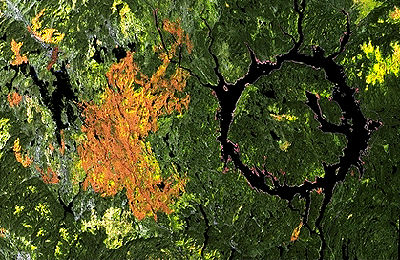Browse "Places"
-
Article
I'm Alone
I'm Alone, a rumrunner based in Lunenburg, NS, one of several hundred vessels that supplied illicit liquor to a PROHIBITION-bound US during the 1920s. In March 1929 a US Coast Guard cutter sighted it when it had engine trouble in the Gulf of Mexico.
"https://development.thecanadianencyclopedia.ca/images/tce_placeholder.jpg?v=e9dca980c9bdb3aa11e832e7ea94f5d9" // resources/views/front/categories/view.blade.php
https://development.thecanadianencyclopedia.ca/images/tce_placeholder.jpg?v=e9dca980c9bdb3aa11e832e7ea94f5d9
-
Article
Meteors, Meteorites and Impact Craters
The solar system contains many objects smaller than the planets (or their satellites) travelling in individual orbits about the SUN; space between the planets also contains myriad dust grains in the micron size range. Near Earth, dust concentrations are only a few hundred particles per cubic kilometre, but 35 000 to 100 000 t of extraterrestrial material enters the atmosphere annually, swept up by our planet from debris that is in its path or crosses its path.
"https://d2ttikhf7xbzbs.cloudfront.net/media/media/66e2415e-3179-44e5-a06b-e73edf3aa050.jpg" // resources/views/front/categories/view.blade.php
https://d2ttikhf7xbzbs.cloudfront.net/media/media/66e2415e-3179-44e5-a06b-e73edf3aa050.jpg
-
Article
Indian Head
Indian Head, Sask, incorporated as a town in 1902, population 1815 (2011c), 1634 (2006c). The Town of Indian Head is located in the heart of Saskatchewan's richest farming area, south of the Qu'Appelle Valley, 69 km east of
"https://development.thecanadianencyclopedia.ca/images/tce_placeholder.jpg?v=e9dca980c9bdb3aa11e832e7ea94f5d9" // resources/views/front/categories/view.blade.php
https://development.thecanadianencyclopedia.ca/images/tce_placeholder.jpg?v=e9dca980c9bdb3aa11e832e7ea94f5d9
-
List
Indigenous Names of Rivers and Lakes in Canada
The names of many rivers and lakes in Canada have Indigenous origins. These bodies of water are named for Indigenous people, places, and aspects of Indigenous culture. Some of these lakes and rivers still bear the original name given to them by Indigenous people. Others have been renamed using an Indigenous word as a means of recognizing Indigenous history and working toward reconciliation. This list article explores the Indigenous names of five rivers and five lakes in Canada. (See also Longest Rivers in Canada and Largest Lakes in Canada.)
"https://d2ttikhf7xbzbs.cloudfront.net/media/media/19ec5b64-165b-4f1c-b539-c89700680c09.jpg" // resources/views/front/categories/view.blade.php
https://d2ttikhf7xbzbs.cloudfront.net/media/media/19ec5b64-165b-4f1c-b539-c89700680c09.jpg
-
Article
Ingersoll
Ingersoll, Ont, incorporated as a town in 1865, population 12 146 (2011c), 11 760 (2006c). The Town of Ingersoll is situated on the THAMES RIVER, 36 km east of London.
"https://development.thecanadianencyclopedia.ca/images/tce_placeholder.jpg?v=e9dca980c9bdb3aa11e832e7ea94f5d9" // resources/views/front/categories/view.blade.php
https://development.thecanadianencyclopedia.ca/images/tce_placeholder.jpg?v=e9dca980c9bdb3aa11e832e7ea94f5d9
-
Article
Innisfail
Innisfail, Alta, incorporated as a town in 1903, population 7876 (2011c), 7331 (2006c). The Town of Innisfail is located on the CP Rail line 121 km north of Calgary.
"https://d2ttikhf7xbzbs.cloudfront.net/media/media/1e459b6f-fe80-4090-8780-016a87e863bd.jpg" // resources/views/front/categories/view.blade.php
https://d2ttikhf7xbzbs.cloudfront.net/media/media/1e459b6f-fe80-4090-8780-016a87e863bd.jpg
-
Article
Innisfil
Innisfil, Ontario, incorporated as a town in 1991, population 43,326 (2021 census), 36,566 (2016 census). The town of Innisfil is located 75 km north of Toronto along the shore of Lake Simcoe.
"https://d2ttikhf7xbzbs.cloudfront.net/media/media/4541da10-f493-4d2b-bf7b-9e1a825d7c64.jpg" // resources/views/front/categories/view.blade.php
https://d2ttikhf7xbzbs.cloudfront.net/media/media/4541da10-f493-4d2b-bf7b-9e1a825d7c64.jpg
-
Article
Innuitian Region
The Innuitian Region (also known as the Innuitian Orogen) is one of Canada’s six geological regions.
"https://d2ttikhf7xbzbs.cloudfront.net/media/media/5176d9ce-bf5f-4fdf-9453-c0f71b3128e6.jpg" // resources/views/front/categories/view.blade.php
https://d2ttikhf7xbzbs.cloudfront.net/media/media/5176d9ce-bf5f-4fdf-9453-c0f71b3128e6.jpg
-
Article
Intendant's Palace Archaeological Site
The site of the Intendant's Palace is in the Lower Town of Québec City below the Côte du Palais.
"https://development.thecanadianencyclopedia.ca/images/tce_placeholder.jpg?v=e9dca980c9bdb3aa11e832e7ea94f5d9" // resources/views/front/categories/view.blade.php
https://development.thecanadianencyclopedia.ca/images/tce_placeholder.jpg?v=e9dca980c9bdb3aa11e832e7ea94f5d9
-
Article
Intercolonial Railway
The Intercolonial Railway was a rail line that operated from 1872 to 1918, connecting Nova Scotia, New Brunswick, Québec and Ontario. The line was Canada’s first national infrastructure project. Plans for its construction date to the 1830s, but the project only gained momentum during the Confederation conferences of 1864 in Charlottetown and Québec City, where construction of the Intercolonial Railway was negotiated for the Maritime colonies’ entry to British North American union. Construction began shortly after Canada became a country in 1867, with most lines completed by the mid-1870s.
"https://d2ttikhf7xbzbs.cloudfront.net/Intercolonial_Locomotive_76.jpg" // resources/views/front/categories/view.blade.php
https://d2ttikhf7xbzbs.cloudfront.net/Intercolonial_Locomotive_76.jpg
-
Article
Intergenerational Trauma and Residential Schools
Historical trauma occurs when trauma caused by historical oppression is passed down through generations. For more than 100 years, the Canadian government supported residential school programs that isolated Indigenous children from their families and communities (see Residential Schools in Canada). Under the guise of educating and preparing Indigenous children for their participation in Canadian society, the federal government and other administrators of the residential school system committed what has since been described as an act of cultural genocide. As generations of students left these institutions, they returned to their home communities without the knowledge, skills or tools to cope in either world. The impacts of their institutionalization in residential school continue to be felt by subsequent generations. This is called intergenerational trauma. This is the full-length entry about Intergenerational Trauma and Residential Schools. For a plain-language summary, please see Intergenerational Trauma and Residential Schools (Plain-Language Summary).
"https://development.thecanadianencyclopedia.ca/images/tce_placeholder.jpg?v=e9dca980c9bdb3aa11e832e7ea94f5d9" // resources/views/front/categories/view.blade.php
https://development.thecanadianencyclopedia.ca/images/tce_placeholder.jpg?v=e9dca980c9bdb3aa11e832e7ea94f5d9
-
Article
Inuit Experiences at Residential School
Residential schools were government-sponsored religious schools created to assimilate Indigenous children into Euro-Canadian culture. Schools in the North were run by missionaries for nearly a century before the federal government began to open new, so-called modern institutions in the 1950s. This was less than a decade after a Special Joint Committee (see Indigenous Suffrage) found that the system was ineffectual. The committee’s recommendations led to the eventual closure of residential schools across the country.
"https://d2ttikhf7xbzbs.cloudfront.net/InuitResidentialSchool/Inuit-Residenital-School (Library and Archives Canada_PA-042133).jpg" // resources/views/front/categories/view.blade.php
https://d2ttikhf7xbzbs.cloudfront.net/InuitResidentialSchool/Inuit-Residenital-School (Library and Archives Canada_PA-042133).jpg.jpg)
-
Article
Inuvik
Inuvik, NWT, incorporated as a town in 1970, population 3463 (2011c), 3484 (2006c). The Town of Inuvik is located on the MACKENZIE RIVER delta, 97 km south of the BEAUFORT SEA and 1086 air km northwest of Yellowknife.
"https://d2ttikhf7xbzbs.cloudfront.net/media/media/e6b68eba-9d02-4243-97c0-eb058faa8ce2.jpg" // resources/views/front/categories/view.blade.php
https://d2ttikhf7xbzbs.cloudfront.net/media/media/e6b68eba-9d02-4243-97c0-eb058faa8ce2.jpg
-
Article
Invermere
Invermere, British Columbia, incorporated as a district municipality in 1983, population 3,391 (2016 census), 2,955 (2011 census). The District of Invermere is located on the northwestern shore of Windermere Lake in the Rocky Mountain Trench. Invermere is 130 km north of Cranbrook and 120 km southeast of Golden.
"https://development.thecanadianencyclopedia.ca/images/tce_placeholder.jpg?v=e9dca980c9bdb3aa11e832e7ea94f5d9" // resources/views/front/categories/view.blade.php
https://development.thecanadianencyclopedia.ca/images/tce_placeholder.jpg?v=e9dca980c9bdb3aa11e832e7ea94f5d9
-
Article
Iqaluit
Iqaluit, Nunavut, incorporated as a city in 2001, population 7,429 (2021 census), 7,740 (2016 census). Iqaluit is the capital and largest community in Canada’s newest territory, Nunavut. It is also the territory's only city. Iqaluit is situated at the northeast head of Frobisher Bay, on southern Baffin Island. In an area long used by the Inuit and their ancestors, it is surrounded by hills close to the Sylvia Grinnell River and looks across the bay to the mountains of the Meta Incognita Peninsula.
"https://d2ttikhf7xbzbs.cloudfront.net/TCEImages/413364c4-0f53-4564-9ec5-2090b6387005.jpg" // resources/views/front/categories/view.blade.php
https://d2ttikhf7xbzbs.cloudfront.net/TCEImages/413364c4-0f53-4564-9ec5-2090b6387005.jpg
